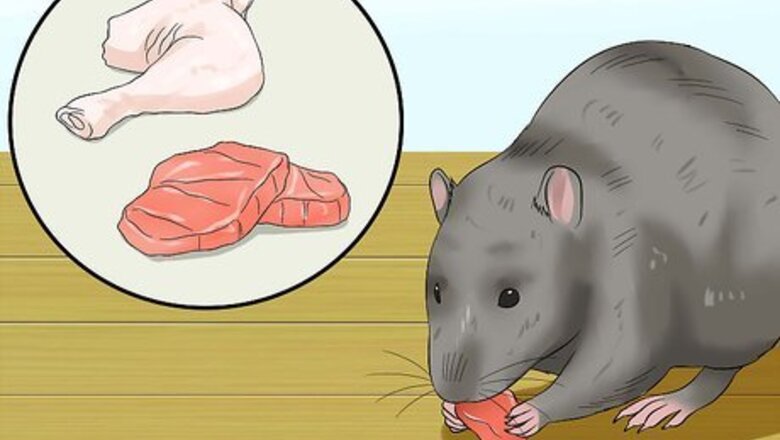
views
What to Feed Your Rat
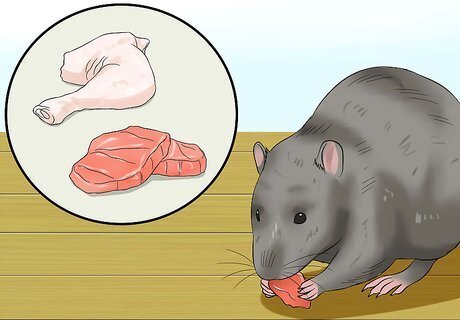
Give your rat enough protein. Lab blocks are often available in varieties with varying levels of protein meant to be matched to an individual rat’s unique nutritional needs. Rats are omnivores and can eat meat as well, but it should not be a normal part of the rat’s diet. Pregnant rats, babies, and young rats need more protein than normal adults. Watch for signs your rat may be protein-deficient, such as: Chronic infections Stress fractures in bones Hair loss

Go organic. Pesticides have a variety of harmful impacts on rats, including thyroid disruption, reduced antibody count, and complications of the endocrine system. In order to ensure your rat stays healthy, buy as much organic produce as possible. If you buy conventional produce: Scrub surface of your fruit/vegetable vigorously with a soapy solution Rinse with water Peel or scrape the outer skin off and discard
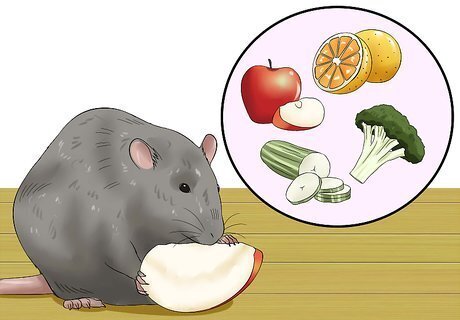
Provide fresh fruits and vegetables. In addition to rat pellets, rats should eat a variety of fibrous fruits and veggies; but not just any vegetables and fruits will do. Some produce is bad or even harmful for rats to eat. Acceptable fruits include apples, pears, bananas, melons, berries, and citrus fruits. Acceptable vegetables include broccoli, cabbage, celery, carrots, parsley, and fresh corn. Unacceptable fruits include mangoes and green bananas. Unacceptable vegetables include raw sweet potato, dried corn, avocado, raw beans, and raw artichokes. Approximately one tablespoon of fruits and veggies per day is enough for a healthy adult rat.

Show some love. Like humans, rats enjoy the occasional treat. Semi-sweet chocolate, orange juice, cookies, and potato chips will be happily consumed by rats. However, don’t make foods high in sugar, fat, and salt a regular part of the rat’s diet. Doing so could lead to obesity and other health problems. EXPERT TIP Brian Starr Brian Starr Rat Specialist & Breeder Brian Starr is a Rat Specialist and Breeder and the Owner of OC Dumbos out of Central Florida. As America’s only breeder of pet Roof Rats, Brian and OC Dumbos specialize in rat breeding, training, and care. Years of experience and several generations of careful breeding have allowed Brian and OC Dumbos to create a line of tame Roof Rats, bred to make friendly, fun pets. In addition to offering rat accessories and training resources, OC Dumbos also offers free Roof Rat adoptions. Brian Starr Brian Starr Rat Specialist & Breeder Keep an eye on a maturing male rat's food intake. Reduce obesity risk in adult male rats by minimizing high-fat treats, and giving them low-protein diets that prevent weight gain. Stay alert for any sense of impaired mobility, like limping, which could indicate joint stress from excess body fat.
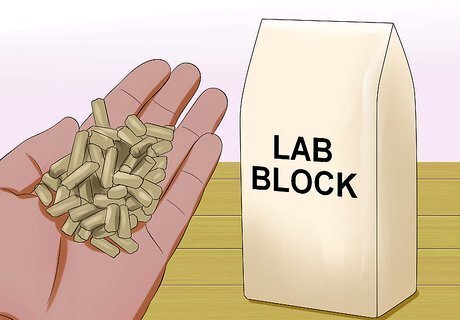
Choose a good lab block. Lab blocks provide the best nutrition for rats. These are specially-formulated food compounds designed for rats in captivity to receive all the nutrition they need. There are a multitude of lab blocks available. Some of the more reputable brands include: Oxbow lab blocks come in two types: young and “regal” (adult). Harlan Teklad offers varieties of lab blocks differentiated by the protein content: 14%,16%, 18%, and 23% varieties depending on the rat’s needs. Mazuri and Purina, both owned by the same parent company Land O Lakes, also produce high-quality lab blocks. Lab blocks are available for sale online or in pet stores. Don’t buy mixes containing lab blocks and seeds, nuts, corn, and fruit. Rats will select the latter and leave the blocks untouched, leading to nutritional shortfalls. Issue a small bowl of lab blocks once a day to your healthy adult rat.

Provide fresh water. Having fresh water at all times ensures the rat is not at risk for dehydration. You can either provide a bowl of water or a bottle. In either case, fill and change the water each day. If you provide a bowl of water, the rats can also use it to bathe themselves. Be sure to wash the bowl daily. If you provide a bottle of water, make sure the mouthpiece is accessible by even the smallest rats in the cage. Check the mouthpiece regularly to ensure it is free of blockage, and give the bottle a few taps to make sure water flows freely. Be sure to empty and clean it weekly, as algae can grow inside.
How to Feed Your Rat
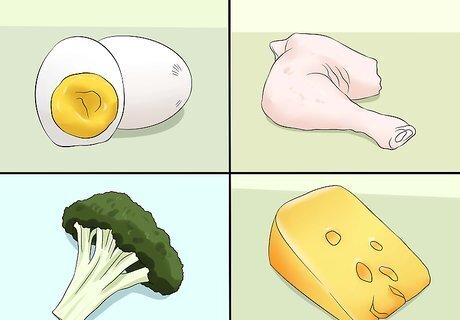
Provide a variety of food. Rats have particular palettes and should be able to make some choices about what food they want to eat. Maintaining a healthy but diverse diet will keep rats curious about and interested in their food. Hard-boiled eggs or food encased in a cardboard wrapper that needs to be opened somehow will stimulate rats and provide them with a learning opportunity.
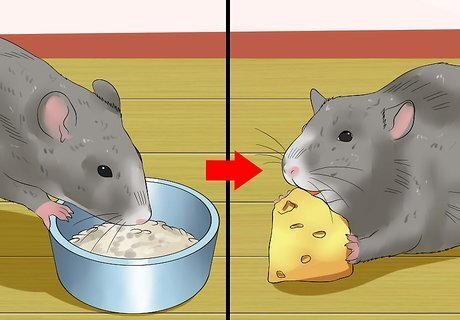
Introduce new foods slowly. If a rat eats too much of a food that disagrees with their constitution, they might have stomachaches or diarrhea. When they have a small quantity, though, they will learn whether or not they should leave it next time they encounter it. If you have several pet rats, make sure that when introducing a new food, you give all of them a taste. If only one rat gets a treat and the others don’t, they will smell the new food on the lucky rat later and may become aggressive.
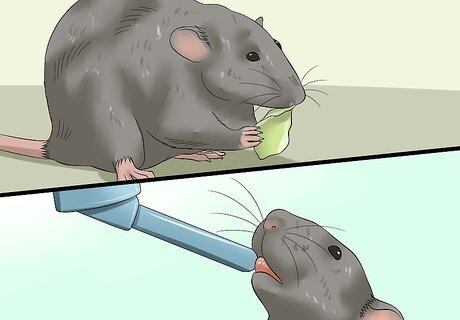
Ensure your rat is getting an adequate amount of food. Always make sure food and water are available to all rats. This requires providing enough food for each rat as well as ensuring water bottles are within reach of the baby rats, who are more vulnerable than adults to hunger and dehydration. Rats can be aggressive. If you have several rats to a cage, be sure to provide a sufficient amount of food for each. Alpha rats (the leaders of the pack) or aggressive rats may hoard food for themselves. Always provide at least two food and water sources when housing multiple rats together. Rats should eat between 10% and 20% of their body weight each day.

Permit natural behaviors. Whether it’s handling food, consuming cecal pellets, or digging for food, rats should be given space to follow their biological instincts. Rats eat their own feces – called cecal pellets – in order to gain important nutritional content. Preventing or disrupting this behavior could result in nutritional deficiencies in your pet rat. Let your rats handle small nuts and seeds. Do not feed them these foods frequently, however, because they are high in fat. Rats like to forage and search for food. If you place a small snack in a sealed cardboard tube or in an unusual place, rats will seek it out.
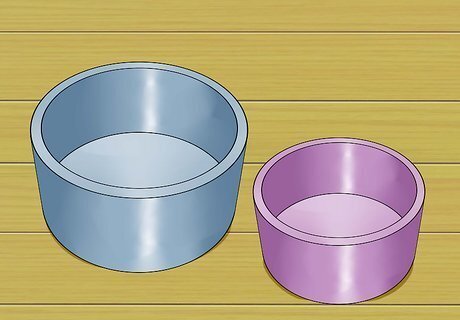
Choose your food containers carefully. Metal bowls can produce sound frequencies which may disrupt the rats. Use ceramic bowls instead. Ceramic bowls are also heavier, and therefore harder for the rats to tip over when feeding. Finally, choose a small bowl; the larger the bowl, the less cage space the rat has.


















Comments
0 comment